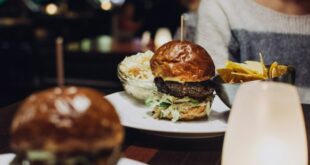Bui Thanh Tam was surprised to see long lines of Japanese queuing in front of doner kebab stalls at an Asian market in Tokyo, while few people sought banh mi (Vietnamese-style baguette sandwich).
“I think Vietnamese banh mi has a more balanced flavor and is healthier,” said Tam, 32.
He said banh mi has been a trend in Europe, touted as one of the best street foods in the world. Noticing its sparse presence in Japan, the central province of Quang Nam native contacted his older brother Bui Thanh Duy to discuss establishing a “Banh mi Xin Chao” (Banh mi saying hello) brand in the country.
The name originated when Tam noticed Asian market traders guessing the nationality of passersby to greet them. Being greeted “Xin chao!” (Hello!) in a foreign country as he passed by made a lasting impression on him.
Duy, five years Tam’s senior, had just married at the time. He embraced his brother’s business plan and proposed to his wife the idea of investing the money they received as gifts at their wedding in Banh mi Xin Chao.
The two brothers were also backed by other family members, who were not affluent but still supported them. Their family borrowed VND2 billion (US$82,500) to help the brothers start their business.
“I bet my energy, intellect, youth, and even my brother’s family future on the project,” Tam said. “So, I had to give it my all, meticulously carrying out a detailed plan.”
 |
|
Bui Thanh Tam (R) and his brother Bui Thanh Duy (L) pose with a Japanese customer at their Banh mi Xin Chao sandwich shop. Photo courtesy of Tam and Duy |
The brothers soon encountered their first challenge on entering the stringent Japanese market: foreigners wishing to obtain a business permit in the country needed a Japanese person to act as their guarantor, as a way to prevent unsuccessful business operators from merely fleeing Japan in debt.
The two Vietnamese men managed to persuade their former university professor to vouch for them.
“Our professor joked that he would have to sell his house to pay our debts if anything bad happened to our business,” Duy recalled.
To compete with other food and beverage businesses in Japan, Tam also decided to establish a professional image for his and Duy’s brand and products. He was determined to stand out and to eventually build a chain of stores. He thus created a complete brand identity for his sandwich right from the beginning.
The siblings opened their first banh mi shop in Tokyo’s Takadanobaba neighborhood in 2016, a year after conceiving the idea. Including Duy and Tam, the shop has five employees.
They serve Central ancient town Hoi An-style banh mi, featuring fillings including grilled pork and pâté. To adapt to local Japanese taste preferences, they made sure to offer banh mi with lighter filling options like chicken salad, or shrimp and avocados.
 |
|
Banh mi served with grilled pork filling is the best seller at Banh mi Xin Chao. Photo from Banh mi Xin Chao’s Facebook |
The hardest ingredient to source was the banh mi baguette bread itself, which needs to have a crispy exterior and a dense, soft interior. The brothers had to contact more than 50 factories before finding something they were satisfied with because most Japanese factories had never made Vietnamese-style banh mi. Many suppliers were unwilling to work with the risky, unproven new business as well.
Meeting the extremely strict food safety standards in Japan was another thing that took the brothers a lot of effort. Meat had to be frozen to the lowest possible temperature level, while 100% of the vegetables used had to be from supermarkets and thoroughly documented.
Supervising the shop’s operation process and serving customers simultaneously, the brothers had only one to two hours a day to sleep when they just started. They even slept on cardboard laid on the store floor.
Tam graduated from the Yokkaichi University four months after that, with his thesis on Banh mi Xin Chao’s startup process achieving the highest score in his department that year. Chunichi, one of Japan’s four major newspapers, contacted the brothers for an interview, and their business then gained significant attention and attracted many more Japanese customers.
The brothers decided to open a second location in Asakusa, one of Tokyo’s busiest districts, in July 2019.
However, everything seemed to collapse when Covid-19 hit later that year. When the government issued lockdown orders, Asakura “became deserted.”
As an attempt to adapt to the situation, the brothers leveraged the portability of their products, focusing on selling takeaways and delivery through online apps. They also offered various promotional campaigns to retain customers.
Combined with the aid it received from the Japanese and Tokyo government, Banh mi Xin Chao gradually recovered. The support from local authorities motivated the Vietnamese siblings to be even more determined in bringing Vietnamese banh mi to local eaters.
“Many Japanese customers say they now eat banh mi almost every day,” Tam said.
 |
|
A Banh mi Xin Chao store in Kobe, Japan. Photo from Tam’s Facebook |
Tam and Duy started franchising their brand after the pandemic, which brought Banh mi Xin Chao even more success. The brand now has a total of 15 branches across Japan and generated a cumulative annual revenue of US$1.6 million in 2022.
Various other Vietnamese traditional dishes are now served at Banh mi Xin Chao stores as well: namely pho, coffee, and sweet soup desserts. Applying the cloud kitchen model, all of the ingredients are prepared at the brand’s Tokyo-based center kitchen before being delivered to other branches.
The brand has become so successful that its Asakusa branch in Tokyo welcomed President Vo Van Thuong, his wife Phan Thi Thanh Tam, along with Tokyo Governor Koike Yuriko and leaders of major Japanese corporations during the Vietnamese president’s official visit to Japan Nov. 27-30.
The president said he felt happy and proud enjoying Vietnamese cuisine in Japan, and even more so seeing how young Vietnamese expatriates were working to deepen the relationship between the two countries’ people through food traditions.
His thoughts shared similarities with Banh mi Xinh Chao’s philosophy, according to Tam.
“We want to serve as a connecting point for Vietnamese expatriates in Japan,” Tam said. “We also want to leave Japanese people with the impression that Vietnamese people do not only work hard, but also do business well.”
President Vo Van Thuong and Tokyo Governor Koike Yuriko enjoy banh mi in Tokyo, Nov. 28, 2023.Video courtesy of Banh mi Xin Cha
- Reduce Hair Loss with PURA D’OR Gold Label Shampoo
- Castor Oil Has Made a “Huge” Difference With Hair and Brow Growth
- Excessive hair loss in men: Signs of illness that cannot be subjective
- Dịch Vụ SEO Website ở Los Angeles, CA: đưa trang web doanh nghiệp bạn lên top Google
- Nails Salon Sierra Madre
 VnExpress News The News Gateway of Vietnam
VnExpress News The News Gateway of Vietnam






